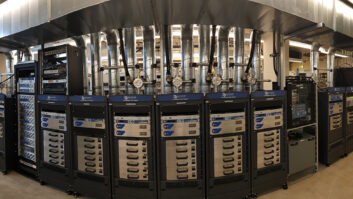Growing demand from more subscribers for higher wireless data rates is forcing wireless carriers to upgrade the backhaul links serving an ever increasing number of cell sites. Copper circuits are being replaced with fiber, but at some locations running new fiber is difficult and expensive. One solution could be a new technology developed by AOptix, which combines a millimeter wave radio and infrared laser. The two devices are mounted on a tower or building in a box roughly the size of a coffee table and provide data rates up to 2 Gbps over distances up to 10 km, even in fog and rain.
The laser is designed to automatically compensate for the swaying of the cell tower in the wind using technology AOptix developed for the Pentagon to actively steer laser beams to keep data moving between ground stations and aircraft.
Chandra Pusarla, senior vice president of products and technology at AOptix said the combination of radio and laser paths allows an AOptix link to guarantee a rate of 2 Gbps with only five minutes or less downtime in a year, whatever the weather conditions. The radio provides a solid link during fog conditions, which blocks the laser link and the laser link returns the favor by providing communications when the millimeter wave radio signals are absorbed by rain drops. Data rate is limited by the radio link, but AOptix says bandwidth could be increased to 4 Gbps in the future.
Three U.S. carriers are reported to be testing the technology as well as one Nigerian customer. Mexican telecommunications company Car-sa recently switched on the first of several links to cell phone towers. Networking company Anova Technologies will use the AOptix technology to link high-speed trading systems in New Jersey.
See Laser-Radio Links Upgrade the Internet in MIT’s Technology Review for more information on the system and a picture of the device.
This article was originally posted on Radio World’s sister siteTVTechnology.com.












